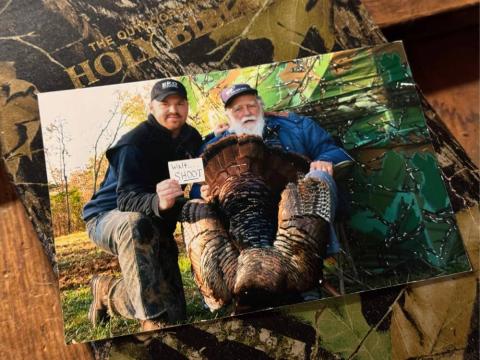Text and photography by Tes Randle Jolly
Nothing triggers a turkey hunter into fitful dreams and self-imposed sleep deprivation like bushy beards, lusty gobbles and limb-hanger spurs. However, some parts of a turkey’s anatomy—beaks, feet, legs and yes, the coveted spurs, are worthy of a closer look at how they function in the species’ survival. This column will discuss their structure and roles.
Important insight is included from wild turkey expert and researcher, Dr. Michael J. Chamberlain, PhD., Terrell Distinguished Professor of Wildlife Ecology and Management at Warnell School of Forestry and Natural Resources at the University of Georgia.
Beaks—A Mouthpiece and More

Turkey beaks are more than the exit point of thundering gobbles and seductive hen calls. They serve as the avian version of a survival multi-tool. Turkeys are avid samplers and use their beak to probe, peck, pluck and snip when securing food items. It also plays a vital role in skin and feather maintenance. The sturdy tip scrapes dirt toward the body when a bird dusts to smother parasites and absorb oil. When preening, feathers are stripped through the beak to clean and realign. The beak is used to extract and rub oil from the uropygial gland on the feathers as a conditioner.
The sharp beak is a formidable weapon for dominance battles. Beak-locked birds in shoving matches may hold the bizarre position for long periods when dominance battles determine breeding rights. Beaks are daggers for eye gouging and pincers that pull skin and caruncles to throw an opponent off balance.
Read More: The Different Personality Types of a Gobbler
Ever wonder if turkeys possess a sense of taste? They have just a fraction of the 9000 taste buds of humans.
Dr. Chamberlain: “As far as taste, it’s believed turkeys have a poor sense of taste and that they are likely able to detect simple tastes such as sweet and bitter. It appears that color and shape play a more important role in what foods turkeys select than taste.”
Feet and Legs Form a Firm Foundation

Sturdy legs and feet find food and support a turkey’s large body. They’re swift runners at 15-25 miles per hour when escaping danger and the legs aid in lift off into flight. Like chickens, turkeys actually walk on their toes, not their feet, which are the shanks, (where the spurs grow). The ankle is the joint where scales meet feathers and the knee is the joint at the top of the drumstick. Toms generally have longer toes—four or more inches from the heel to the tip of the middle toe. Poults and juvenile turkeys have grayish legs that turn pinkish to red with aging.
Dr. Chamberlain: “Obviously, turkeys use their legs to walk around and run away from danger, but those same legs are instrumental to turkeys being true omnivores – meaning they have an incredibly diverse diet. Unlike many gamebirds, turkeys have rugged legs and feet with pronounced nails which allow them to scratch and even dig to find food when conditions get tough. This ability allows turkeys to eat many food items – early researchers said that turkeys were opportunists but not picky, were as omnivorous as the human race, and might be the master opportunist. In fact, research evaluating turkey diets has shown that they will readily consume more than 300 species of plants and an equal number of animal species! Turkeys will disturb leaf litter to find hard mast and invertebrates, scratch the soil to find tubers and buried seeds, and even dig through snow to locate food underneath. In livestock areas turkeys tear apart livestock waste to find food.”
Spurs—Weapons of Defense for Dominance

Spurs are built-in defense weapons and capable of inflicting significant injury. All turkeys are born with a small bump on the lower legs. It grows into a spur on most toms as the bird ages. Except in very rare cases the button-like spot remains unchanged throughout a hen’s life. Rarely, a tom may have no spurs, one spur or double spurs. They grow throughout a bird’s life and age can be estimated by them in the first three years of life. One-year-old jakes grow up to a 1/2”, blunt nub, two year olds’ spurs generally are straight and 1” or so. Three year olds have slightly curved, pointed spurs. Terrain can affect spur length and shape. Osceola wild turkeys hold record for the longest limbhangers—upwards of 2 inches or more.
Read More: The 5 Subspecies of the Wild Turkey
Dr. Chamberlain: “The core of the spur is bone that is covered with keratin and varies in color from black, pink or pale white. Spurs are used as a form of defense by toms when they fight, but whether spurs have other functions such as an involvement in mate selection is unknown. Reports of hens with spurs, are quite rare. Toms with multiple spurs are rare, but toms with no spurs can be quite common in some areas.”





























